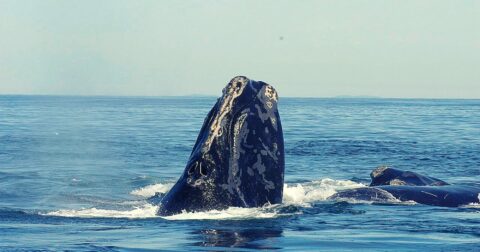News
Meat Consumption Grows in US and Asia, While Europe is on the Decline
Climate•3 min read
Reported
There are ways to reduce risk to dwindling right whale populations, but only if lawmakers and industry have the will to take action.


Words by Jenny Splitter
There is a strange — yet entirely false — notion about whales and wind farms that seems to keep circulating in U.S. coastal communities, says right whale researcher Oliver Boisseau. The senior scientist is part of a team aboard a 70 foot long sailing boat called Song of the Whale, docked in Washington, DC earlier this month to bring attention to what puts the North Atlantic right whale at risk.
It’s not wind farms, says Boisseau, despite just how persistent this myth seems to be. In fact, there’s no mystery about what does kill right whales: collisions with ships and fishing lines. The good news is there are solutions — ways to reduce harm to these critically endangered creatures — but only if lawmakers and industry have the will to take action.
There are just under 340 North Atlantic right whales left today. Dubbed the “right whale to hunt” hundreds of years ago because they swam slowly, floated after death and yielded large amounts of oil and baleen, a filtering system from their mouths used to make corsets.
Today, whale hunting is banned in many countries and is no longer the primary cause of dwindling North Atlantic right whale populations. Now, it’s lobster and jonah crab catch and collisions with ships.
According to Kathleen Collins, who leads the right whale campaign for the International Fund for Animal Welfare or IFAW, there are ways to reduce risk from both vessel strikes and entanglements in lobster and jonah crab lines — speed restrictions on vessels, especially in the path of right whales, and wider adoption by the lobster and jonah crab industry of what’s called “on demand” gear. This newer type of gear uses GPS and acoustics to time when to send pots into the water, avoiding the problem of ever-present lines that tangle and kill whales.
Not too long ago, federal policy was poised to shift in the right direction. A working group of regulators, scientists, industry and conservation groups had reached an agreement on new rules requiring adoption of on-demand gear by the lobster and jonah crab industries. But this past December, Maine senator Susan Collins introduced a rider that delayed implementation by six years. Last month, a new bill was introduced by Arizona house member Raul Grivala to repeal the rider’s language but its future remains uncertain. According to Maine Public Radio, it has “a few Democratic co-sponsors.”
Commissioned by IFAW, the Song of the Whale research team uses acoustic technology to listen and detect whale calls, what Boisseau describes as a window into the right whale world. Their calls are much quieter than orcas, and baby right whales are even quieter, like a whisper, he says.
Right whales don’t sleep like we do, says Boisseau, “they’re active 24 hours a day.” But because they can’t see well in the dark, they rely on sound to get around. In fact, whales use acoustics in just about everything they do — sound is their primary sense, says Boisseau. They use it for communication and navigation, and also “to find their prey.”
The team also uses drones to assist responders in detangling whales, recently helping to free a whale from 375 feet of fishing rope. The aerial views help the team estimate the width of the whale and where it’s tangled up.
Climate change is also putting right whale populations at further risk. Scientists recorded what they call an unusual mortality event in 2017 and, though the exact cause wasn’t known, the whales shifted their migration routes northwards to avoid warming waters. When migratory paths change, vessels aren’t always aware to be on the lookout for right whales, which is why oversight of shipping speed limits is so important.
While docked in DC, first mate Killian Glynn led tours of visitors through the vessel, a handful at a time, giving people a chance to hear what whales sound like. In addition to better gear, reducing demand for lobster and crab is also a way to save right whales, he points out: “don’t eat lobster.”